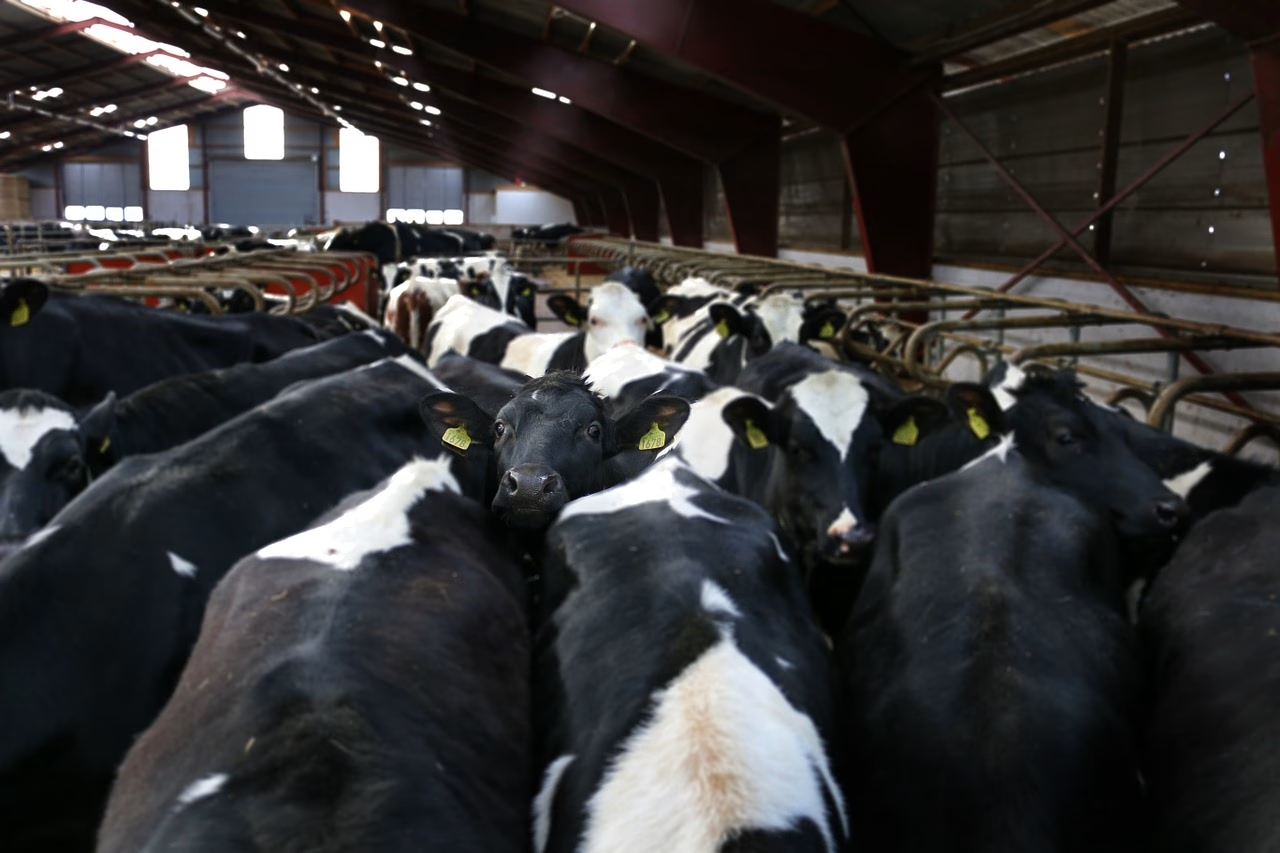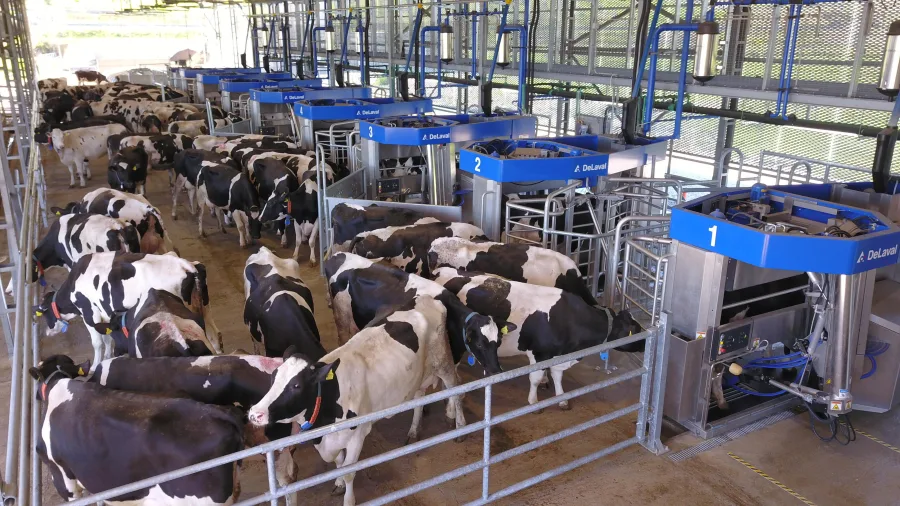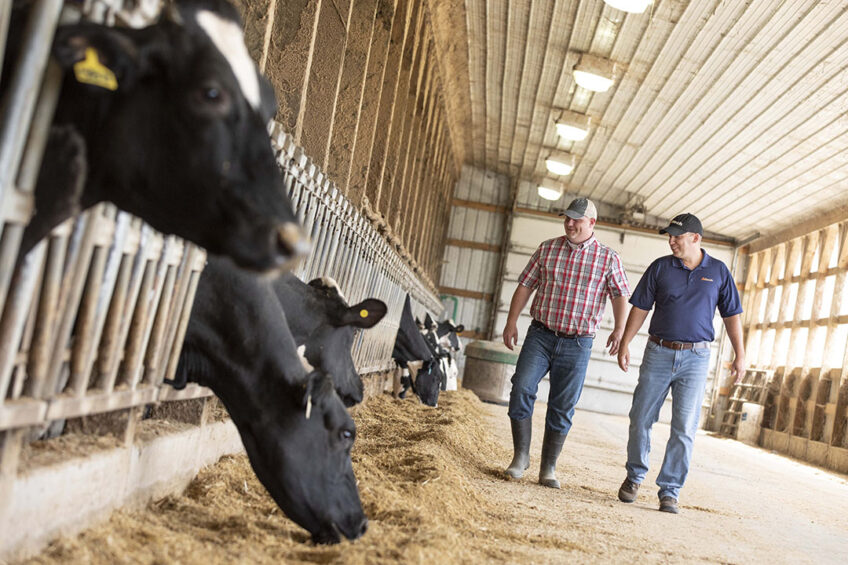Uncover the obscured expenses associated with “crowded cows” in agriculture and animal welfare. What repercussions does this practice have on our food supply and the health of livestock?

Overcrowding in dairy production, sometimes called ‘crowded cows,’ has become a significant worry for agricultural communities. Farmers must prioritize herd care and enhance productivity to meet the increased demand for dairy products. Overcrowding harms cow health, reducing farm output and sustainability. It causes sickness, stress, inefficiencies in milk production, and greater death rates. Stress and lack of relaxation may lead to a 10% loss in milk supply, costing a farm up to $50,000 per year. However, tackling ‘packed cows’ and encouraging sustainable and humane dairy farming may help livestock and livelihoods while increasing the dairy industry’s economic sustainability.
The Consequences of Spatial Overload in Dairy Farming
| Cow Density | Number of Stalls per Cow |
|---|---|
| Low (<80% stocking) | 1.2 |
| Moderate (80%-100% stocking) | 1.0 |
| High (>100% stocking) | 0.8 |
Crowded cows occur when the number of animals exceeds the required space for their health, production, and well-being. This problem stems from a lack of bunk space, resting locations, and restricted supplies such as water and food. A dairy cow requires around one stall. For pasture operations, they need about 120 square feet per cow. Exceeding this limit has negative repercussions, including increased resource competition, reduced dry matter intake (DMI), and decreased milk production. However, farmers may dramatically increase their herds’ well-being and productivity by emphasizing cow comfort and following these geographical guidelines.
The Impact of Overcrowding on Dairy Cow Welfare: Stress, Health, and Behavioral Issues
| Metric | Optimal Conditions | Overcrowded Conditions | Percentage Difference |
|---|---|---|---|
| Milk Production (liters/day) | 25 | 18 | -28% |
| Incidence of Mastitis (%) | 10% | 30% | +200% |
| Average Longevity (years) | 6 | 4 | -33% |
| Feed Conversion Efficiency | 1.5 | 1.2 | -20% |
Overcrowded circumstances harm dairy cows’ welfare, causing physical pain and other issues. Competition for food and rest places leads to elevated stress levels, which may weaken immune function and increase susceptibility to illnesses like mastitis and respiratory infections. Crowded herds might lead to behavioral difficulties. Cows become more aggressive as they fight for space, inflicting injuries and disrupting herd peace. Stress and dissatisfaction may cause aberrant repeated behaviors like frequent licking and pacing, indicating significant welfare inadequacies.
| Overcrowding Factor | Impact on Milk Production |
|---|---|
| Increased Competition for Food | Decreased nutrient intake, leading to lower milk yield |
| Elevated Stress Levels | Reduction in milk quality due to hormonal imbalances |
| Limited Resting Space | Reduced time for necessary rest and rumination, impacting milk production |
| Poor Ventilation | Higher susceptibility to respiratory diseases, adversely affecting milk yield. |
The Ripple Effect: From Stress to Severe Health Complications in Dairy Cows
Overcrowding has significant health consequences beyond acute stress, including lameness, mastitis, and respiratory difficulties. These circumstances jeopardize dairy cows’ well-being and production while imposing significant economic expenses on producers. Lameness, caused by extended standing on hard surfaces and little rest owing to restricted space, hinders movement and lowers feeding, influencing nutrition and energy intake, both of which are critical for milk production. Poor mobility might lead to increased stress and decreased milk supply.
Mastitis, an inflammatory illness of the udder, is aggravated by overcrowding, significantly when hygiene standards deteriorate owing to overpopulation. This illness lowers milk quality and quantity, needing expensive veterinarian interventions and lengthy therapies. Respiratory problems are common in overcrowded barns with poor ventilation, promoting diseases that quickly spread across the herd and reduce output. Chronic respiratory difficulties often result in higher culling rates, lowering each animal’s lifetime and return on investment.
Finally, these health conditions considerably impair dairy cows’ productivity and lifetime, resulting in lower milk output, medical costs, and profitability. Overcrowding poses health risks that must be addressed to maintain a healthy dairy enterprise.
Compromised Milk Production: The Immediate Impact of Overcrowding
| Overcrowding Level | Milk Production (lbs/day) | Impact on Production (%) |
|---|---|---|
| Optimal Conditions | 70 lbs | 0% |
| 10% Overcrowded | 67 lbs | -4.3% |
| 20% Overcrowded | 64 lbs | -8.6% |
| 30% Overcrowded | 60 lbs | -14.3% |
Dairy overpopulation’s most immediate consequences are decreased milk output and quality. Keeping cows in confined quarters reduces their daily dry matter intake (DMI), resulting in inadequate nutritional absorption for optimum milk production. Cow rivalry intensifies with limited bunk space, prompting some to eat less feed.
Overcrowding triggers deep physiological stress reactions. Stress causes the production of cortisol, a hormone that disrupts reproductive systems and immunological responses. Chronic stress limits the release of oxytocin, which is required for milk letdown, reducing milk quantity and quality.
Furthermore, tight confinement raises the risk of physical injuries and infections such as mastitis, which directly affects milk safety and quality. Cows that lack enough room are more likely to lie in damp or filthy circumstances, increasing the risk of pathogen exposure and milk contamination.
Finally, producers must maintain an ideal group size, ensuring that cows spend less time in holding pens and have easy access to feeding places. Balancing herd size and facility capacity improves cow comfort and productivity, ensuring milk output and quality.
The Unseen Burden: Environmental Stressors Aggravating Dairy Cow Overcrowding
Environmental factors enhance the impact of overpopulation in dairy farms. Poor ventilation may quickly raise ammonia and toxic gasses, aggravating cow respiratory systems and exacerbating illnesses like pneumonia. Inadequate bedding exacerbates this problem, producing comfort issues, foot abnormalities, and increased mastitis rates owing to unsanitary surroundings. Overcrowding often results in restricted availability of food and water, affecting feeding activity and dry matter intake (DMI). Dairy cows need a balanced diet and constant water supply for maximum health and output. Due to limited bunk space, fewer cows can eat the appropriate feed, resulting in decreased DMI, poor body condition, and restricted milk output. This creates a loop in which stressed, undernourished cows are more prone to sickness, lowering herd output. Farmers must manage herd numbers so that each cow has enough room, resources, and comfort. Strategic planning and management are essential for reducing environmental stresses. Addressing these concerns is critical for animal welfare and sustainable dairy production operations.
The Economic Ramifications of Overcrowding in Dairy Farms: A Deep Dive into Profitability and Sustainability
| Economic Cost | Description | Estimated Financial Impact |
|---|---|---|
| Veterinary Costs | Increased frequency of disease and illness due to stress and inadequate living conditions | $50 – $100 per cow annually |
| Feed Efficiency | Higher competition for feed leads to inefficient feeding practices and uneven weight gain | 5% – 15% increase in feed costs |
| Milk Yield and Quality | Reduced milk production and quality, leading to lower market prices | 2% – 10% drop in revenue |
| Infrastructure Maintenance | Accelerated wear and tear on facilities due to higher occupancy | $200 – $500 annually |
| Labor Costs | Increased need for labor to manage overcrowded conditions and stressed animals | Additional $10,000 – $15,000 annually per farm |
Overcrowding on dairy farms substantially influences the industry’s profitability beyond just animal welfare concerns. Crowded circumstances increase veterinarian expenditures due to mastitis, lameness, and respiratory problems. These health issues raise veterinarian expenditures and result in continuous costs for chronic illnesses.
Overcrowding has a direct effect on milk output. Stressed cows consume less, resulting in reduced milk output. Studies indicate that adjusting bunk space and group sizes helps sustain milk production levels. For example, moving a herd from one to two groups may boost fat-corrected milk (FCM) by 1% to 3%. Reduced milk production immediately affects the farm’s capacity to satisfy supply obligations, perhaps resulting in financial fines or lost business.
Furthermore, overcrowding may harm a dairy farm’s image in a market where customers increasingly demand ethically produced goods. Farms notorious for poor animal care may lose their competitive advantage, resulting in lower sales and perhaps expensive marketing attempts to improve their public image.
Regulatory Frameworks and Ethical Considerations: The Backbone of Humane Dairy Farming Practices
To address overpopulation in dairy farms, it’s important to consider regulatory frameworks and ethical principles for animal care. Several jurisdictions have enacted regulations to reduce overcrowding and safeguard the health of dairy cattle. These restrictions prioritize humane procedures, including enough space, nourishment, and general animal well-being. The Animal Welfare Act in several nations ensures humane treatment by promoting natural behaviors and well-being. Guidelines frequently specify stocking density limitations to minimize overpopulation. The European Union’s farm animal welfare regulation establishes minimum space requirements and feed and water availability. Organizations like the American Dairy Science Association and the World Organization for Animal Health recommend best practices beyond legal standards, such as providing enough bunk space and reducing pen time. These criteria emphasize the ethical need to balance production and a healthy animal living environment. Noncompliance may result in penalties, license revocation, and reputational harm. Ethical farming techniques prioritize animal care and promote the sustainability and economic viability of the dairy sector.
Proactive Solutions and Best Practices to Address Overcrowding in Dairy Farms
Improved management approaches are critical for addressing dairy farm congestion. Herd size has to be carefully planned, and cow behavior and health must be monitored. Data analytics can identify ideal group sizes based on feeding activity, milk output, and space availability.
Investing in improved housing facilities with enough sleeping space and rest places decreases stress and health problems. Flexible group size, in line with parlor capacity and holding pen time, ensures efficiency and comfort.
Adherence to animal welfare standards, as set by the Animal Welfare Institute and Michigan State University, promotes a compassionate and successful agricultural environment. Meeting these requirements improves cow welfare, farm sustainability, and customer confidence in dairy products.
The Bottom Line
Overcrowding in dairy farming has profound implications that must be addressed immediately. Overcrowding increases stress, health difficulties, and behavioral problems, lowering milk supply and affecting animal welfare and economic returns. Environmental factors exacerbate these difficulties. Herd density management is critical for both long-term sustainability and profitability. Optimizing welfare and economic viability requires correct grouping tactics, lowering group variance, and improving facility design and administration. Compliance with regulatory and ethical norms is vital for humane and sustainable activities. Our job is to improve procedures that benefit the animals and the industry. These methods balance production and animal care, promoting long-term profitability and sustainability in dairy farming.
Key Takeaways:
- Proper spatial management in dairy farming is crucial for the well-being and productivity of dairy cows.
- Overcrowding leads to increased stress, health issues, and behavioral problems among dairy cows.
- The ripple effect of stress from overcrowding can escalate into severe health complications.
- One immediate impact of overcrowding is a notable decline in milk production.
- Environmental stressors can exacerbate the negative effects of overcrowding on dairy cows.
- Overcrowding has significant economic ramifications, affecting profitability and sustainability of dairy farms.
- Regulatory frameworks and ethical considerations are fundamental to implementing humane farming practices.
- Adopting proactive solutions and best practices can effectively address the issue of overcrowding in dairy farms.
Summary:
Overcrowding in dairy production, also known as ‘crowded cows,’ is a significant issue that affects cow health, farm output, and sustainability. It can lead to sickness, stress, inefficiencies in milk production, and increased death rates. Overcrowding can cost farms up to $50,000 per year. To address this issue, farmers should focus on sustainable and humane dairy farming and follow geographical guidelines. The recommended number of stalls per cow is 120 square feet or one stall. Exceeding this limit can lead to increased resource competition, reduced dry matter intake, and decreased milk production. Farmers can improve their herds’ well-being and productivity by emphasizing cow comfort and following geographical guidelines. Overcrowding conditions also cause physical pain, competition for food and rest places, elevated stress levels, limited resting space, and poor ventilation. These factors lead to increased competition for food, decreased nutrient intake, reduced milk quality due to hormonal imbalances, and respiratory diseases. Overcrowding triggers physiological stress reactions, leading to the production of cortisol and limited release of oxytocin, reducing milk quantity and quality. Proactive solutions to address overcrowding include improved management approaches, careful planning of herd size, monitoring cow behavior and health, investing in improved housing facilities, and adhering to animal welfare standards set by organizations like the Animal Welfare Institute and Michigan State University.













